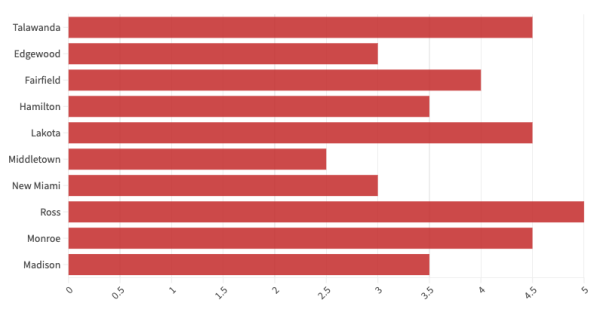Talawanda District receives a 4.5 out of five stars on its report card from the Ohio Board of Education and the Department of Education and Workforce (DEW) for the second year in a row.
The report card system was implemented in 2023 and focuses on five main components: achievement, progress, gap closing, early literacy and graduation rate. Each district can earn up to 25 stars and is given an overall, averaged grade. Talwanda district received 22 out of 25 stars — one star short in progress, achievement and early literacy.
Lindsey Gregg, Talwanda’s director of teaching and learning, attributes the high report card success to the hard work of teachers and students, despite recent hardships.

“We’ve been through it all in the past five years, and I think that our teachers, as you know, frustrated as they probably felt in some of those situations, it gave them even more ammunition to put students first here and we want to make sure that we’re doing everything we can,” said Gregg.
Each individual school also receives up to 20 stars and an overall rating out of five. Talawanda High School was awarded 18 out of 20 with an overall of 4.5 stars, the highest rating of all the high schools in the district, according to the Ohio Report Cards website.
One of the highlighted contributing factors of the high rating, according to Gregg, is the school’s gap closing efforts. Nine different subgroups are identified in the district and high school. The administration has closed all of them with the exception of students with disabilities where they are around 2% from closing it.
The Talawanda school district is proud of its overall ratings and has already made plans to enhance areas of growth, said Gregg. Last year, the district implemented data and collaboration days where faculty deep-dive into data on academics, mental health, attendance and more.
“There are four days that we implemented last year and into this year, above and beyond those three PD days, where staff actually do a data protocol in the morning,” said Gregg. “They focus on looking at and analyzing data to see where we can improve in those areas.”
Talawanda also created an ELA/literacy committee to find ways to enhance youth literacy in their schools. The committee is made up of faculty members and intervention specialists. Since the creation of the committee, the school district saw over a 20% increase in reading proficiency among third graders in just five years. This year they plan to implement a new curriculum for K-12 with new, improved understandings of the reading and literacy skills.
Gregg also accounts the higher rating to the recent offerings of college-credit plus classes (CCP). CCP courses allow for students to transfer their credits to colleges/universities once they graduate. To receive transfer credit, a student must earn a C or higher in the class. Although AP classes are a great option, many colleges cannot guarantee they will accept them as transfer credits even if a student passes.
“A lot of times, out-of-state schools want to see a four or five on some of those AP tests,” said Gregg. “They were having some difficulty getting a four or five, or if they got a three, it wouldn’t transfer. With CCP, we are seeing students being able to carry those credits to college, which we felt was important.”
The Talawanda district has a few new ideas they hope to implement in the near future including a math literacy committee, closing gaps and more, according to Gregg. Future plans will be discussed at the monthly school board meeting at 8 p.m., Thursday, Sept. 19. The meeting will take place in the high school auditorium and will be live on Talawanda’s YouTube channel.






